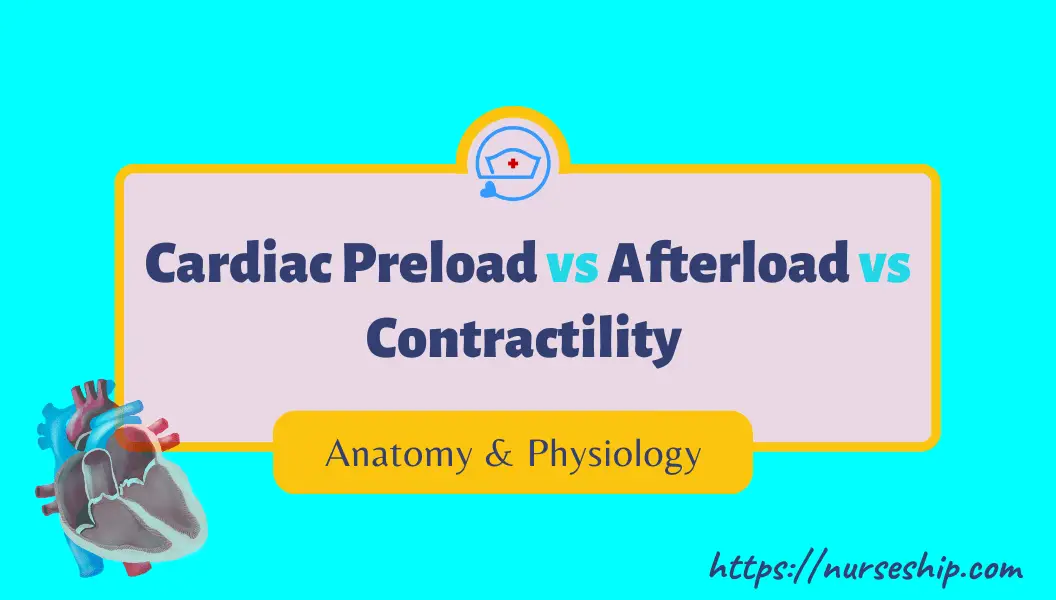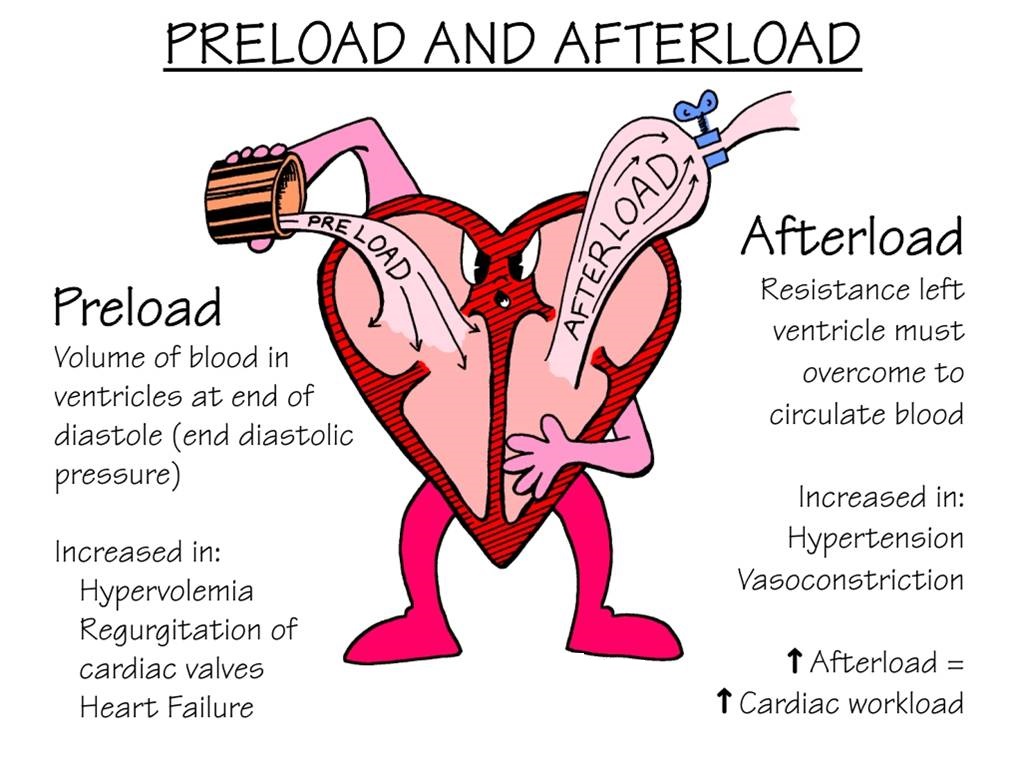
Ventricular PressureVolume Relationship Preload, Afterload, Stroke Volume, Wall Stress & Frank
Cardiac output is the amount of blood the heart pumps in 1 minute, and it is dependent on the heart rate, contractility, preload, and afterload. Understanding of the applicability and practical relevance of each of these four components is important when interpreting cardiac output values.

Physiology of the Heart online presentation
Preload can be defined as the initial stretching of the cardiac myocytes prior to contraction. Preload, therefore, is related to muscle sarcomere length.Because sarcomere length cannot be determined in the intact heart, other indices of preload are used, such as ventricular end-diastolic volume or pressure.. When venous return to the heart is increased, the end-diastolic pressure and volume of.

Elements of Cardiac Function Berne and Levy Physiology, 6th ed
Afterload is largely dependent upon aortic pressure. Afterload is the pressure that the heart must work against to eject blood during systole (ventricular contraction). Afterload is proportional to the average arterial pressure. [1] As aortic and pulmonary pressures increase, the afterload increases on the left and right ventricles respectively.

Cardiomyopathy Preload vs Afterload YouTube
How Afterload Affects Stroke Volume and Preload. As shown in the figure, an increase in afterload shifts the Frank-Starling curve down and to the right (from point A to B), which decreases stroke volume (SV) and increases left ventricular end-diastolic pressure (LVEDP). The basis for this is found in the force-velocity relationship for cardiac.

Cardiac Output and Cardiac Index Preload, Afterload, Contractility, And More Explained
This wall stress is what causes the distention in the cardiac myocyte. Another definition of preload is that "preload is the pressure on the ventricular wall prior to contraction (i.e. at the end of diastole). Afterload = "LV wall stress during ejection". Unlike preload which is the wall stress at a specific point in time, the afterload.

Difference Between Preload and Afterload Compare the Difference Between Similar Terms
Also termed left ventricular end-diastolic pressure (LVEDP), preload is a measure of the degree of the ventricular stretch when the heart is at the end of diastole. Preload, in addition to afterload and contractility, is one of the three main factors that directly influence stroke volume (SV), the amount of blood pumped out of the heart in one cardiac cycle.[1] Affected by changes in venous.

Ventricular PressureVolume Relationship Preload, Afterload, Stroke Volume, Wall Stress & Frank
📝 Find notes here: https://www.nonstopneuron.com/post/preload-and-afterload-for-ventricles-of-the-heartExplore our entire animation video library: https://w.

Cardiac Preload vs Afterload vs Contractility With an example
The systolic performance of the heart is determined by 3 factors: preload, afterload, and contractility. The direct relationship between preload and cardiac output was formulated in the early 1900s based on the work of Otto Frank and Ernest Starling. It led to the well-known Frank-Starling curves. Gordon et al. helped to elucidate the underlying mechanism for this phenomenon in their 1966.

Physiology Glossary Cardiac Performance (CO, SV, Preload, and Afterload) Draw It to Know It
One of the really nice things about preload and afterload is that the two have so much in common. So if you're trying to figure out afterload, then remembering what preload is about is a really good idea because the definitions are so similar. So we have volume and pressure on this graph. I'm actually going to start by sketching out very.

This is an example of preload and afterload heart hearthealth fitness body design
Edema can be caused by: 1. high arterial blood pressure. 2. venous obstruction. 3. leakage of llama proteins into interstitial fluid. 4. myxedema (excessive production of certain glycoproteins in the extracellular matrix caused by hypothyroidism) 5. decreased plasma protein concentration.

CVS physiology lecture 11 PRELOAD vs AFTERLOAD. YouTube
In this video, Dr Mike explains all the factors that contribute to cardiac output. This includes the complex terms PRELOAD and AFTERLOAD!

What Are Preload and Afterload? Faculty of Medicine
Heart during ventricular diastole. In cardiac physiology, preload is the amount of sarcomere stretch experienced by cardiac muscle cells, called cardiomyocytes, at the end of ventricular filling during diastole. [1] Preload is directly related to ventricular filling. As the relaxed ventricle fills during diastole, the walls are stretched and.

PPT Cardiac Muscle Contraction PowerPoint Presentation, free download ID6530818
Cardiac output is the volume of blood the heart pumps per minute. Cardiac output is calculated by multiplying the stroke volume by the heart rate; normal cardiac output is about 4 to 8 L/min but varies depending on the body's metabolic needs. Cardiac index is a calculation of the cardiac output divided by the person's body surface area (BSA).

Ventricular PressureVolume Relationship Preload, Afterload, Stroke Volume, Wall Stress & Frank
Check out this Free Hemodynamic Value Cheatsheet To Help You Understand Cardiac https://nursing.com/cheat-sheets/Understanding Preload and Afterload is a lot.

preload and afterload Nursing mnemonics, Nursing school survival, Icu nursing
The heart is an intricate organ that causes quite a bit of bewilderment, especially with nursing students. And one of the topics that bring about such confusion is concerned with preload and afterload. Consider this analogy - the heart is like a slingshot; a slingshot that requires pressure when pulling and energy upon release.

Preload and Afterload Animation (What do they mean? How to measure) YouTube
Preload vs. afterload nursing review of stroke volume and cardiac output. What is cardiac preload and afterload?Cardiac preload is the amount the ventricle s.